Inbox and Environment News: Issue 264
May 22 - 28 2016: Issue 264
The Countdown is on for the Youth Match Racing World Championships in New Caledonia

May 20, 2016: RPAYC
RPAYC's Will Dargaville and his team of Josh Dawson, Sarah Parker and James Farquarson will be travelling to
This June, Will and the team will be facing competitors from New Zealand, Denmark, America, Japan and France. New Caledonia to compete in the Youth Match Racing World Championships in Noumea. He won the Youth Match Racing Championships in New Caledonia last October and along with that win also won the Hardy Cup. These strong wins brought Will into the top 50 in the Open Mens Match Racing World Rankins which resulted in Will being selected to take one of the two spots to represent Australia. Harry Price from the CYCA is the other Australian selected.
The Nouméa Yacht Club (CNC) will host the competition on an isolated Island in front of Noumea, the main city. Competitors from six nations will sail in paradise, in the biggest lagoon of the world, surrounded by turtles, tropical fishes and dugongs.

Will competing in the 2015 HARKEN Youth Match Racing Champs.
Tomorrow's Digitally Enabled Workforce
This report examines plausible futures for jobs and employment markets in Australia over the coming twenty years.
THE CHALLENGE
Why is now any different?
Whilst Australia's workforce is continually changing the current period in history is characterised by a combination of forces likely to be associated with greater, faster and different transitions than previously experienced.
OUR RESPONSE
Megatrends and Scenarios
The study has identified six megatrends for jobs and employment markets over the coming twenty years.
Report cover image with report title in black and a image of a laptop on a desk next to a stack of books.Show high resolution image
1. The second half of the chessboard
The explosion in device connectivity, data volumes and computing speed, combined with rapid advances in automated systems and artificial intelligence means that robotic devices can perform many tasks more quickly, safely and efficiently than humans.
2. Porous boundaries
Digital technology and the new world of ‘platform economics’ is changing employment markets and organisational structures. Jobs of the future are likely to be more flexible, agile, networked and connected.
3. The era of the entrepreneur
The ideal job within a large organisation may not be awaiting an increasing number of future job seekers. This means individuals will need to create their own job. This will require entrepreneurial skills and aptitudes.
4. Divergent demographics
Along with many other advanced and emerging economies, Australia’s population is ageing with growing life expectancies. Retirement ages are likely to push back further and an organisation’s employee profile is likely to contain more diverse age groups and more diverse cultural backgrounds.
5. The rising bar
Increased use of automated systems is raising the complexity of tasks and requiring higher skill levels for entry-level positions. Income growth in Asia is associated with increased educational and skills levels, as well as growing competition for Australia’s labour force. Many low skilled jobs are being offshored or automated. The consequence is the likelihood of a raised skills and education bar for entry into many professions and occupations.
6. Tangible intangibles
Employment growth in the service industries, in particular education and healthcare, has driven job creation in recent times. This is likely to continue into the future as we move to a knowledge economy. Service sector jobs requiring social interaction skills and emotional intelligence will become increasingly important.
THE RESULTS
Informed decisions for planning
Following is a summary of the main implications, which will help to inform individuals, communities, companies and government on planning for the future of a digitally enabled workforce.
New skills and mindsets are needed for the future
- Education and training is becoming ever more important
- New capabilities are needed for new jobs of the future
- Digital literacy is needed alongside numeracy and literacy
- The changing importance of STEM (whilst participation rates are in decline)
- Aptitudes and mindsets to handle a dynamic labour market
- Challenging perceptions and norms about job types
- Improving workforce participation in vulnerable demographics
- Towards tapered retirement models
- New models to forecast job transition requirements
- Improved understanding of the peer-to-peer (and freelancer) economy
Tomorrow's Digitally Enabled Workforce: Megatrends and Scenarios for jobs and employment in Australia over the next twenty years [pdf · 7mb]
Biodiversity protects fish from climate change
May 16, 2016
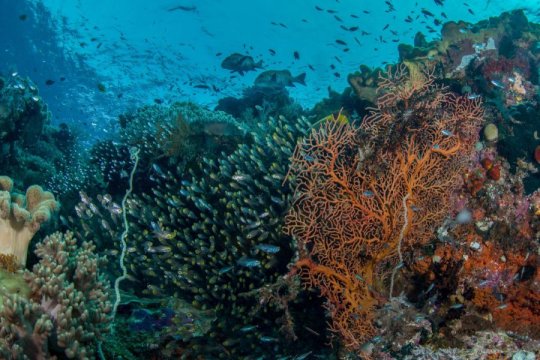
These are reef fishes in the global center of fish diversity, Raja Ampat, West Papua. Credit: Rick Stuart-Smith
Fish provide protein to billions of people and are an especially critical food source in the developing world. Today marine biologists confirmed a key factor that could help them thrive through the coming decades: biodiversity. Communities with more fish species are more productive and more resilient to rising temperatures and temperature swings, according to a new study from the Smithsonian's Tennenbaum Marine Observatories Network and other international institutions.
The accelerating loss and rearrangement of species all over the globe have troubled scientists and the public for decades. But the question of whether biodiversity offers practical value--for humans and ecosystems--remained controversial. The new study, published May 16 in the Proceedings of the National Academy of Sciences, offers the most thorough proof yet that preserving marine biodiversity can benefit people as much as it benefits the oceans.
"Biodiversity is more than a pretty face," said lead author Emmett Duffy, director of the Tennenbaum Marine Observatories Network and senior scientist at the Smithsonian Environmental Research Center. "Preserving biodiversity is not just an aesthetic or spiritual issue--it's critical to the healthy functioning of ecosystems and the important services they provide to humans, like seafood."
The discovery came out of the Reef Life Survey, a comprehensive program that has conducted surveys of more than 3,000 fish species in 44 countries around the world. Many of the surveyors were volunteer citizen scientists, about a third of whom had no scientific background. Volunteer divers from 11 countries received training from the program's lead scientists at the University of Tasmania to collect data using standardized methods.
"This study is based on more than 4,000 underwater surveys," said co-author Rick Stuart-Smith of the University of Tasmania. "It was only possible with the enthusiastic contributions of highly trained volunteer divers in the Reef Life Survey program, which allowed us to achieve this comprehensive coverage of the world's reefs, from tropical to polar waters."
Armed with the most comprehensive global dataset on marine biodiversity involving standardized counts, the researchers tracked how 11 different environmental factors influenced total fish biomass on coral and rocky reefs around the world. Surprisingly, one of the strongest influences was biodiversity: The number of species (species richness) and the variety in how they use their environment (functional diversity) enhanced fish biomass. The boost in fish resources provided by biodiversity was second only to that of warm temperatures.
Temperature had a more complex relationship with fish biomass: Warmer ocean temperatures tended to boost fish biomass on average, while wider temperature fluctuations hindered it. But biodiversity made fish communities more resilient against changing climate. In communities with only a few species, fish biomass tended to increase with rising temperatures until seas warmed above 20 degrees Celsius (68 degrees Fahrenheit)--at which point biomass started to fall. But communities with many species remained stable at these higher temperatures.
The researchers found a similar buffering effect of diversity against temperature swings. While both high- and low-diversity communities were less productive under fluctuating temperatures, high-diversity communities suffered only half as much as low-diversity ones. The researchers suspect communities with more species are better equipped to handle temperature changes because they have more of their bases covered. When temperatures fluctuate, a community with numerous species has better odds that at least a few species can thrive in the new normal.
"This work is a critical step forward in linking insights from experiments in buckets and garden plots to the larger world," said co-author Jonathan Lefcheck of the Virginia Institute of Marine Science, referring to earlier biodiversity experiments done with plants and small animals in gardens or greenhouses. "It shows that experimental ecologists have in fact been on the right track for 20 years, and that biodiversity is paramount to how natural systems work."
"Results demonstrate that preserving local biodiversity is not only an ethical directive with aesthetical and genetic insurance value, but that it is an imperative for human life," said co-author Sergio Navarrete of the Pontifical Catholic University of Chile.
J. Emmett Duffy, Jonathan S. Lefcheck, Rick D. Stuart-Smith, Sergio A. Navarrete, and Graham J. Edgar. Biodiversity enhances reef fish biomass and resistance to climate change. PNAS, May 2016 DOI: 10.1073/pnas.1524465113
Nominations open for the 2016 NSW Green Globe Awards
Media release: 16 May 2016
Nominations are now open for the 17th Green Globe Awards celebrating NSW's exceptional environmental achievements.
Ian Hunter, Deputy Chief Executive, NSW Office of Environment and Heritage (OEH) said the Green Globe Awards are NSW's biggest sustainability awards, with ten award categories covering a range of resource, business, community and individual sustainability initiatives.
"The Awards are a chance to showcase NSW's green game changers nationally, internationally and celebrate the people behind the successes," Mr Hunter said.
"They provide a platform for participants to showcase innovative work, initiate projects, network and reach new audiences."
Previous winner, Chris Bins of City of Sydney, said their Green Globe Award had opened further opportunities to share their experiences and give them licence to push harder into the new horizons of sustainability.
"We've offered our Green Globe experience as an open invitation for discussion and knowledge sharing," Mr Bins said.
Brookfarm, winner of the 2015 Small Business Sustainability and Premier's Award for Environmental Excellence said since winning both awards they have implemented a rainwater harvesting system and energy management initiatives to meet new environmental certification goals.
Winner of last year's Young Sustainability Champion Award, Seda Hamoud, said her award has given her school Environmental Club an even stronger cross-school component and has allowed for greater membership.
Robin Mellon, Green Globe Award judging panel chair of chairs said the judges are excited to see this year's nominations and how nominees are reducing their environmental impacts in a diverse collection of ways.
"We look forward to seeing how their initiatives are really 'leading the pack' around NSW, Australia and hopefully around the world and how their actions are having a positive effect on businesses, people and communities," Mr Mellon said.
The NSW Green Globe Award winners set the gold standard in becoming a cleaner and greener state.
The Awards will be judged by a panel of independent experts and presented at a gala night at The Art Gallery of New South Wales in late October 2016.
Nominations are open until 11 July 2016. To enter your project, program or nominate, please go to:www.environment.nsw.gov.au/greenglobes
Western Woodlands Koala Report
May 17, 2016: National Parks Association of NSW
BREAKING NEWS: An alarming new report shows that koalas across a massive two thirds of NSW face extinction from habitat loss and climate change -
westernwoodlands.weebly.com/koala-report.html
And this comes at the same time as our government is unveiling new laws which will see land clearing escalate to a catastrophic level.
In light of this report we are calling on the government to take immediate action to protect all remaining koala habitat - please share this news to show your support.
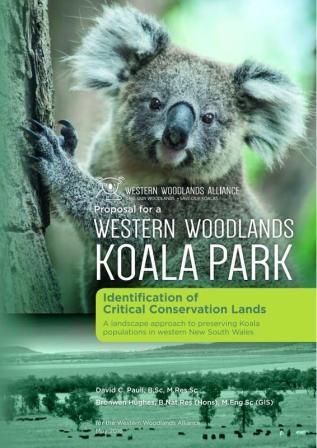
Land clearing and climate change threaten koalas in western NSW
17 May, 2016: Nature Conservation Council
The Baird government’s plans to allow more land clearing will increase the likelihood of koalas becoming extinct in western NSW, the NSW Nature Conservation Council has warned.
A report launched today by former Office of Environment and Heritage officer David Paull found local populations of koalas across most of the state faced extinction from habitat loss and climate change unless the government protected remnant koala woodlands. [1]
“Land clearing is one of the biggest threats to our koalas in NSW, particularly in the state’s western regions where its habitat has become severely fragmented by more than 200 years of tree-clearing,” NCC CEO Kate Smolski said.
“The weaker land-clearing laws that the Baird government is pushing through will make the extinction of koalas in some parts of the state much more likely.
"If Premier Baird wants to ensure koala’s long-term survival, he must abandon the Biodiversity Conservation Bill that he unveiled earlier this month and go back to the drawing board.”
Recent events have highlighted the need for urgent action to save the koala from extinction:
The number of koalas on the east coast of Australia plummeted by more than 40 per cent between 1990 and 2010, the equivalent of only three koala generations. [2]
In 2012, the Federal Government listed the NSW, Queensland and ACT populations as vulnerable under the Environment Protection and Biodiversity Conservation Act. [3]
Survey’s conducted by ecologists in 2013 in the massive Pilliga forest in the state’s northwest, an area once considered a stronghold for the species, found the population had crashed by 75 per cent in 10 years. That koala population is now considered “highly endangered”. [4]
“It is quite clear that if these trends continue and dramatic action is not taken to protect and connect habitat remnants, koalas will become extinct in the wild in NSW, possibly in our lifetime,” Ms Smolski said.
“We support the Western Woodlands Alliance’s call for the government to make significant additions to the reserve system in NSW, and to target funding for private land conservation.
"Given the koala’s status as a national icon, we hope that all political parties will support urgent action to ensure its prospects for long-term survival, and that means maintaining strong, effective controls on land clearing.”
REFERENCES
[1] http://westernwoodlands.weebly.com/koala-report.html
[2] Koala populations in NSW and Queensland fell 42% from 326,400 to 188,000 (a loss of 138,400 individuals) in the 20 years from 1990 to 2010. On current trends, koalas will be extinct in the wild in NSW by 2030. Habitat loss, fragmentation and degradation, predation (dogs and vehicle strike), disease, drought, climate change, and inbreeding are keys threats. www.environment.gov.au/cgi-bin/sprat/public/publicspecies.pl?taxon_id=85104#population_information
[3] Koala populations in Queensland, New South Wales and the Australian Capital Territory and national environment law, www.environment.gov.au/biodiversity/threatened/publications/factsheet-koala-populations-queensland-nsw-act-national
[4] Could there be as few as 50 Koalas left in the Pilliga? http://www.abc.net.au/local/stories/2014/12/15/4148934.htm
New Era In Land Management and Conservation
Tuesday, 3 May 2016: NSW OEH Media Release
The NSW Government has released its consultation package to overhaul ineffective, complicated environmental laws and create a new system that improves both environmental outcomes and farmers’ productivity.
Under the new system, routine farm work would be exempt from regulation, farmers would be able to plan for the future to improve their productivity, and the government would provide farmers with incentives to conserve native plants and trees on their land.
The reforms would also protect and enhance the environment with an historic investment of $240 million over five years in private land conservation, $70 million in each following year and $100 million dedicated over five years to the “Saving Our Species” program.
Deputy Premier Troy Grant said the NSW Government was delivering on its commitment to repeal the Native Vegetation Act and create laws that both protect the environment and give farmers a fair go.
“For too long the burden of these laws has rested on the shoulders of farmers – and I am
proud we are one step closer to repealing this legislation and delivering on the independent panel’s recommendations to reform land management in this state,” Mr Grant said.
Environment Minister Mark Speakman said the new laws would take a strategic approach to conservation and would complement the Commonwealth’s biodiversity protections.
“We are delivering a simple and effective way to use and protect land that is backed by record government investment to build a network of conserved lands on private property.
“We have tough measures to protect endangered ecological communities supported by Commonwealth protections that will conserve our biodiversity for future generations.”
Minister for Primary Industries Niall Blair said the reforms would give farmers an opportunity to make informed choices on what works best for their land.
“Our farmers are our frontline environmental custodians and it makes sense to give them the flexibility to manage and protect the land that is the lifeblood of our regional communities.”
The reform package will:
• Ensure land clearing is assessed under a single set of rules, simplifying the task of farmers in managing their land
• Conserve biodiversity at a bioregional level
• Give landholders incentives to conserve biodiversity on private land
• Reverse the historical decline of biodiversity in NSW
Drafts of the new Biodiversity Conservation Act and amended Local Land Services Act are on public exhibition and open for submissions for the next eight weeks. Details: www.landmanagement.nsw.gov.au
Members of the public are invited to submit their feedback on the proposed biodiversity conservation reform package.
• Draft Biodiversity Conservation Bill (PDF, 755KB)
• Draft Local Land Services Amendment Bill (PDF, 394KB)
The submission guides provide detailed information for members of the public to provide constructive feedback. The guides contain specific consultation questions that can help to inform the development of the reforms.
• Simplifying Land Management submission guide
• Native Vegetation Regulatory Map submission guide
• Ecologically Sustainable Development submission guide
• Protecting Native Plants and Animals submission guide
• Private Land Conservation submission guide
Written submissions can be submitted online using the form on this page or posted to:
Biodiversity Reforms - Have Your Say, Office of Environment and Heritage, PO Box A290, Sydney South. NSW 1232
The public consultation period ends on 28 June 2016 at 5pm.
EPA releases report on koala habitat mapping in NSW state forests
Media release: 16 May 2016
The NSW Environment Protection Authority (EPA) has released a report on koala habitat mapping that was piloted in four state forests in northern NSW.
The mapping pilot aimed to provide a clear understanding of the suitability of various mapping options in improving how koala habitat could be better identified and managed.
The mapping pilot showed that a range of factors influence koala occupancy in suitable habitat areas. These factors, include fire, past disturbance, roads, disease, predation and weeds, making the mapping of koalas and their habitat difficult at times.
The results provide the EPA with important information and data about koalas and their habitat in native forestry areas. This will be vital in helping to understand where koalas are living and how the EPA might better protect and manage their habitats in the future.
For more information about koala mapping program see:www.epa.nsw.gov.au/forestagreements/koala-mapping-program.
2016 Eco School Grants Program open for applications
Media release: 26 April 2016 - NSW Office of Environment and Heritage
Eighty grants of $3,500 each are available to support a range of environmental projects and learning opportunities for students, teachers and school communities under the NSW Environmental Trust's Eco Schools Grants Program.
Terry Bailey, Chief Executive, NSW Office of Environment and Heritage and Trust Secretary said the grants will help provide curriculum-based environmental education, awareness and knowledge to children.
"This Government investment aims to develop students' passion and commitment to protecting the environment," Mr Bailey said.
"The program recognises the important work of the community, no matter how old or young, in environmental conservation projects and I encourage educators and school communities to apply for one of the eighty grants.
"Twenty-five of the grants will be awarded to projects that work primarily with students with special needs.
"Seventy-eight schools were awarded Eco School grants last year and their projects help enhance the environment of NSW. Pennant Hills Public School used their grant funds to plant more small shrubs for their Small Bird Haven project.
"The additional shrubs provide much needed sanctuary for small birds to nest, feed and take shelter from predators. The project also taught students about environmental monitoring," Mr Bailey said.
All NSW primary and high schools, registered with the Sustainable Schools NSW program, can apply for funding, however please see the Program Guidelines for specific eligibility requirements.
Grant applications can be submitted until Friday 17 June, 2016.
Visit the Environmental Trust's website for further information:www.environment.nsw.gov.au/grants/schools.htm
Drone trials up and away
17 May 2016: Department of Primary Industries - NSW Govt.
As part of the NSW Government’s $16 million Shark Management Strategy to trial emerging technology to better detect and deter sharks, expanded trials of Unmanned Aerial Vehicles (UAV), or drone technology, are underway in Port Macquarie this week.
DPI Fisheries’ Senior Research Scientist Dr Paul Butcher said the trial will put different aerial surveillance methods to the test at the same time, to help determine the efficacy of all kinds of aerial surveillance in shark bite mitigation.
“Innovative drone technology is fast becoming a popular tool for surveillance measures across the world,” Dr Butcher said.
“The NSW Government has committed $16 million to the Shark Management Strategy with a special focus on new and emerging technologies.
“This week’s trial in Port Macquarie is the second time we have compared traditional aerial surveillance using an observer inside helicopters, to a drone flying the same path, at the same time.
“Drone technology feeds real time information with GPS co-ordinates back to the operator, and the trial will test the effectiveness of the technology and its role in shark attack mitigation.
“The trial means we’ll be able to compare the vision recorded during the trial and determine the ability of each technology to spot sharks.”
Recent aerial surveillance programs conducted along the NSW coast have shown to be an enormous success, helping alert authorities and the general public when a shark is posing potential danger to swimmers or surfers.
Since January alone, NSW DPI aerial surveillance contractors have cleared the beach 42 times along the NSW Coast, because of potentially dangerous sharks in close proximity to swimmers.
Year-round aerial surveillance is currently underway of a weekend on the NSW North Coast from Point Danger, Tweed Heads to South Ballina.
Aerial surveillance will also be extended to other regions of the coast right down to Twofold Bay during school holiday periods of maximum beach use.
“Sharks seen by the helicopters and deemed to be posing a potential danger to swimmers and surfers will be immediately reported to Police, as well as directly to local Surf Life Saving clubs and other beach authorities at patrolled beaches,” Dr Butcher said.
NSW Department of Primary Industries will also tweet the information via @NSWSharkSmart, and on the SharkSmart app.
Polluted dust can impact ocean life thousands of miles away
May 16, 2016
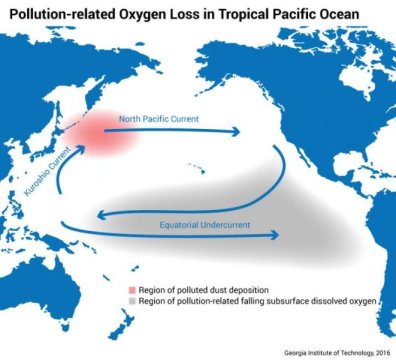
As iron is deposited from air pollution off the coast of East Asia, ocean currents carry the nutrient far and wide. Credit: Georgia Institute of Technology
As climatologists closely monitor the impact of human activity on the world's oceans, researchers at the Georgia Institute of Technology have found yet another worrying trend impacting the health of the Pacific Ocean.
A new modeling study conducted by researchers in Georgia Tech's School of Earth and Atmospheric Sciences shows that for decades, air pollution drifting from East Asia out over the world's largest ocean has kicked off a chain reaction that contributed to oxygen levels falling in tropical waters thousands of miles away.
"There's a growing awareness that oxygen levels in the ocean may be changing over time," said Taka Ito, an associate professor at Georgia Tech. "One reason for that is the warming environment -- warm water holds less gas. But in the tropical Pacific, the oxygen level has been falling at a much faster rate than the temperature change can explain."
The study, which was published May 16 in Nature Geoscience, was sponsored by the National Science Foundation, a Georgia Power Faculty Scholar Chair and a Cullen-Peck Faculty Fellowship.
In the report, the researchers describe how air pollution from industrial activities had raised levels of iron and nitrogen -- key nutrients for marine life -- in the ocean off the coast of East Asia. Ocean currents then carried the nutrients to tropical regions, where they were consumed by photosynthesizing phytoplankton.
But while the tropical phytoplankton may have released more oxygen into the atmosphere, their consumption of the excess nutrients had a negative effect on the dissolved oxygen levels deeper in the ocean.
"If you have more active photosynthesis at the surface, it produces more organic matter, and some of that sinks down," Ito said. "And as it sinks down, there's bacteria that consume that organic matter. Like us breathing in oxygen and exhaling CO2, the bacteria consume oxygen in the subsurface ocean, and there is a tendency to deplete more oxygen."
That process plays out in all across the Pacific, but the effects are most pronounced in tropical areas, where dissolved oxygen is already low.
Athanasios Nenes, a professor in the School of Earth and Atmospheric Sciences and the School of Chemical and Biomolecular Engineering at Georgia Tech who worked with Ito on the study, said the research is the first to describe just how far reaching the impact of human industrial activity can be.
"The scientific community always thought that the impact of air pollution is felt in the vicinity of where it deposits ," said Nenes, who also serves as Georgia Power Faculty Scholar. "This study shows that the iron can circulate across the ocean and affect ecosystems thousands of kilometers away."
While evidence had been mounting that global climate change may have an impact on future oxygen levels, Ito and Nenes were spurred to search for an explanation for why oxygen levels in the tropics had been declining since the 1970s.
To understand how the process worked, the researchers developed a model that combines atmospheric chemistry, biogeochemical cycles, and ocean circulation. Their model maps out how polluted, iron-rich dust that settles over the Northern Pacific gets carried by ocean currents east toward North America, down the coast and then back west along the equator.
In their model, the researchers accounted for other factors that can also impact oxygen levels, such as water temperature and ocean current variability.
Whether due to warming sea waters or an increase in iron pollution, the implications of growing oxygen-minimum zones are far reaching for marine life.
"Many living organisms depend on oxygen that is dissolved in seawater," Ito said. "So if it gets low enough, it can cause problems, and it might change habitats for marine organisms."
Occasionally, waters from low oxygen areas swell to the coastal waters, killing or displacing populations of fish, crabs and many other organisms. Those "hypoxic events" may become more frequent as the oxygen-minimum zones grow, Ito said.
The increasing phytoplankton activity is a double-edged sword, Ito said.
"Phytoplankton is an essential part of the living ocean," he said. "It serves as the base of food chain and absorbs atmospheric carbon dioxide. But if the pollution continues to supply excess nutrients, the process of the decomposition depletes oxygen from the deeper waters, and this deep oxygen is not easily replaced."
The study also expands on the understanding of dust as a transporter of pollution, Nenes said.
"Dust has always attracted of a lot of interest because of its impact on the health of people," Nenes said. "This is really the first study showing that dust can have a huge impact on the health of the oceans in ways that we've never understood before. It just raises the need to understand what we're doing to marine ecosystems that feed populations worldwide."
Takamitsu Ito, Athanasios Nenes, Matthew Johnson, Nicholas Meskhidze, and Curtis Deutsch. Acceleration of oxygen decline in the tropical Pacific over the past decades by aerosol pollutants. Nature Geoscience, 2016 DOI: 10.1038/ngeo2717

Planning Information Day for Middle Head
Media release: 11 May 2016 - NSW Dept. of Environment and Heritage
The National Parks and Wildlife Service (NPWS) and the Sydney Harbour Federation Trust (Harbour Trust) will be hosting a Planning Information Day on the future of Middle Head on Sydney Harbour, which the public are invited to attend on Sunday 22 May from 10am-2pm.
NPWS Deputy Chief Executive Michael Wright and Harbour Trust Acting Executive Director Susan Culverston said that the two separate agencies are aiming to manage Middle Head as one landscape.
"In recognising that the headland is one landscape, NPWS and the Harbour Trust are working together to coordinate planning for the future of this important part of Sydney," Mr Wright said.
"This is NPWS's first step in the process of creating a master plan for the Middle Head precinct in Sydney Harbour National Park that will guide its management over the next 20 to 30 years.
"In considering what our vision for this area should be, we first want to hear what the community's views are on safe and sustainable ways to enhance visitor enjoyment and protect the area's outstanding natural features.
"The Planning Information Day is about hearing what is important to the community about the parkland and how we can continue to make the area an attractive public space for the enjoyment of everyone."
Harbour Trust Acting Executive Director, Dr Culverston said at Middle Head, both agencies are striving to create a unified urban parkland experience.
"We rely heavily on public input to inform our planning for sites like Middle Head," Dr Culverston said.
"The Planning Information Day is an opportunity to hear about our respective planning processes and get a good understanding of what happens in the park now, how we will work together in the future and what themes will be covered in our planning.
"In planning for the site we will consider matters such as current activities, access and circulation, operational requirements, uses for buildings and opportunities for improved public access and interpretation.
"Our planning outcomes will be coordinated to maximise public access and protect the environmental and heritage values of the site so the community can continue to enjoy it well into the future," she said.
Both agencies are preparing planning documents for the land they are responsible for, and are seeking to ensure they effectively integrate their site planning with each other. The feedback from the Planning Information Day will help to inform the drafting of these plans. Once written, these plans will be formally exhibited for public comment.
The Planning Information Day will be held at Middle Head, Mosman.
North Coast apiary industry protected by Operation ‘Honey Pot’
18 May 2016: Department of Primary Industries - NSW Govt.
The Northern River’s beekeeping industry is better protected against pests and diseases following the recent Department of Primary Industries’ (DPI) apiary compliance operation code-named ‘Honey Pot’.
DPI Senior Regulatory Inspector Anne Webster said the operation, conducted in the Richmond and Byron Local Government Areas, involved random and targeted inspections of neglected and abandoned beehives.
“It is important to identify and eradicate any neglected and abandoned hives as they are a major threat to the health of managed beehives,” Ms Webster said.
“There are a number of serious pests and diseases of honey bees that have the potential to decimate the NSW apiary industry.
“Neglected or abandoned hives can be responsible for the spread of the most serious of endemic diseases, American Foulbrood (AFB).”
Ms Webster said during the operation hives were inspected for AFB and enforcement action was taken for the failure to notify NSW DPI of AFB infections and the failure to correctly identify brood boxes.
“A number of the AFB infected hives were owned by commercial and amateur beekeepers and posed a major risk of infecting other apiaries when field bees rob stores from these hives,” Ms Webster said.
“It was necessary to destroy the neglected hives infected with AFB to limit the spread of this bacterial disease to other managed apiaries.
“Most beekeepers were found to do the right thing and comply with regulations, but it was disappointing to find that a number of beekeepers did not correctly identify their hives and one was not registered.”
In NSW anyone that keeps one or more hives is required to be registered with the Department of Primary Industries.
Beekeepers are reminded that it is mandatory to notify a DPI Apiary Inspector within 24 hours of suspecting a hive may have AFB disease.
With the increased interest in keeping bees people are reminded to be aware of the legislation and their responsibilities.
People can report any suspected exotic pests or diseases by phoning the Exotic Disease Hotline 1800 675 888.
Detailed information on honey bees, beekeeper registration, pests and diseases is available on the DPI websitewww.dpi.nsw.gov.au/agriculture/livestock/honey-bees
Tyagarah Nature Reserve Draft Plan
What is the draft plan of management for?
Parks and reserves established under the NSW National Parks and Wildlife Act 1974 are required to have a plan of management. A new draft plan for Tyagarah Nature Reserve has been prepared which will replace its existing plan. The exhibition of the draft plan provides members of the community with the opportunity to have a say in the future management directions for this reserve. Further information about Tyagarah Nature Reserve is available at the NPWS visitor website.
Have your say
Submit your written feedback on the draft plan by 22 August 2016 by using the online submission form on the Office of Environment and Heritage website, or by emailingnpws.parkplanning@environment.nsw.gov.au, or by writing to:
NPWS Planner, Tyagarah Draft PoM, PO Box 1236. Coffs Harbour NSW 2450
Exhibition - Date: May. 13 - Aug. 22, 2016 Time: 9:00am — 5:00pm
Wongarbon Nature Reserve draft plan
The Wongarbon Nature Reserve draft plan of management is on public exhibition until 22 August 2016.
What is the draft plan of management for?
Parks and reserves established under the NSW National Parks and Wildlife Act 1974 are required to have a plan of management. The exhibition of the draft plan provides members of the community with the opportunity to have a say in the future management directions for this reserve.
Have your say
Submit your written feedback on the draft plan by 22 August 2016 in one of the following ways:
By email: email your submission to:npws.parkplanning@environment.nsw.gov.au.
By mail: post your written submission to:
NPWS Wongarbon POM, Planning Evaluation and Assessment Team, PO Box 1967. Hurstville BC NSW 1481
By filling out the online form on the OEH public exhibition page.
Exhibition - Date: May. 13 - Aug. 22, 2016 Time: 10:00am — 5:00pm
POEO Regulatory Amendments
NSW Government: Changes to definitions of Scheduled Activities
What's this about?
The Draft Amendment Regulation will amend Schedule 1 of the Protection of the Environment Operations Act 1997 and Schedule 1 of the Protection of the Environment Operations (General) Regulation 2009 to modify the descriptions of certain scheduled activities and to modify how licence fees are determined.
The proposed amendments will modify the descriptions of the following scheduled activities:
crushing, grinding or separating - extractive activities - dairy animal accommodation - railway systems activities - road construction - petroleum products and fuel production - contaminated soil treatment - resource recovery - waste processing - waste storage.
Have your say
The draft Regulation is on public exhibition until 16 June 2016.
Visit the EPA public exhibition page to view the draft Regulation and the cost-benefit analysis, and to submit your comments.
Visit the questions and answers page to find out more about each proposed amendment to help explain the proposed changes.
Exhibition - Date: May, 18 - Jun. 16, 2016, Time: 9:00am — 5:00pm
Migration Time for Birds
May 19, 2016: BirdLife Australia
A true wildlife spectacle is happening right on our doorstep!
It's not only our shorebirds that migrate during autumn, a whole flock of other Australian birds migrate too.
The swifts head back to their northern hemisphere breeding grounds; Grey Fantails, Silvereyes and Striated Pardalotes fly across Bass Strait to spend the winter on the Australian mainland; Eastern Koels head to New Guinea and possibly Indonesia; Tree Martins and Welcome Swallows head to northern Australia; and Gang-Gang Cockatoos and Flame Robins vacate their mountain homes, heading to the lowlands.
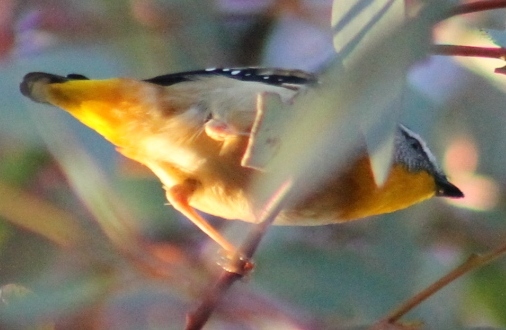
An impressive sight to see is the thousands of Yellow-faced Honeyeaters and other small songbirds forming massive flocks, on the move along the Great Dividing Range on a journey to warmer parts of Australia.
Find out more about Australia's migratory birds:http://birdlife.org.au/media/autumn-is-migration-time/
Above: Striated Pardalote photographed in Ingleside escarpment by A J Guesdon.
Scientists predict extensive ice loss from huge Antarctic glacier
May 18, 2016
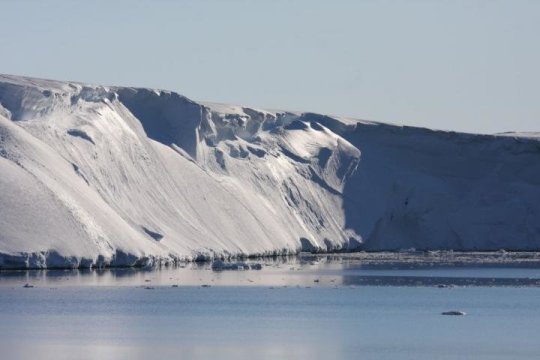
This is a picture of the Totten Glacier front.Credit: Esmee van Wijk/Australian Antarctic Division
Current rates of climate change could trigger instability in a major Antarctic glacier, ultimately leading to more than 2m of sea-level rise.
This is the conclusion of a new study looking at the future of Totten Glacier, a significant glacier in Antarctica. Totten Glacier drains one of the world's largest areas of ice, on the East Antarctic Ice Sheet (EAIS).
By studying the history of Totten's advances and retreats, researchers have discovered that if climate change continues unabated, the glacier could cross a critical threshold within the next century, entering an irreversible period of very rapid retreat.
This would cause it to withdraw up to 300 kilometres inland in the following centuries and release vast quantities of water, contributing up to 2.9 metres to global sea-level rise.
The EAIS is currently thought to be relatively stable in the face of global warming compared with the much smaller ice sheet in West Antarctica, but Totten Glacier is bucking the trend by losing substantial amounts of ice. The new research reveals that Totten Glacier may be even more vulnerable than previously thought.
The study, by scientists from Imperial College London and institutions in Australia, the US, and New Zealand is published today in Nature. Last year, the team discovered that there is currently warm water circulating underneath a floating portion of the glacier that is causing more melting than might have been expected.
Their new research looks at the underlying geology of the glacier and reveals that if it retreats another 100-150 km, its front will be sitting on an unstable bed and this could trigger a period of rapid retreat for the glacier. This would cause it to withdraw nearly 300 km inland from its current front at the coast.
Retreating the full 300 km inland may take several hundred years, according to co-author Professor Martin Siegert, Co-Director of the Grantham Institute at Imperial College London. However, once the glacier crosses the threshold into the unstable region, the melting will be unstoppable -- at least until it has retreated to the point where the geology becomes more stable again.
"The evidence coming together is painting a picture of East Antarctica being much more vulnerable to a warming environment than we thought," he said. "This is something we should worry about. Totten Glacier is losing ice now, and the warm ocean water that is causing this loss has the potential to also push the glacier back to an unstable place."
"Totten Glacier is only one outlet for the ice of the East Antarctic Ice Sheet, but it could have a huge impact. The East Antarctic Ice Sheet is by far the largest mass of ice on Earth, so any small changes have a big influence globally."
To uncover the history of Totten Glacier's movements, the team looked at the sedimentary rocks below the glacier using airborne geophysical surveys. From the geological record, influenced by the erosion by ice above, they were able to understand the history of the glacier stretching back millions of years.
They found that the glacier has retreated more quickly over certain 'unstable' regions in the past. Based on this evidence, the scientists believe that when the glacier hits these regions again we will see the same pattern of rapid retreat.
Journal Reference:
A. R. A. Aitken, J. L. Roberts, T. D. van Ommen, D. A. Young, N. R. Golledge, J. S. Greenbaum, D. D. Blankenship, M. J. Siegert.Repeated large-scale retreat and advance of Totten Glacier indicated by inland bed erosion. Nature, 2016; 533 (7603): 385 DOI: 10.1038/nature17447
NOPSEMA Provides BP Opportunity to Modify Drilling Environment Plan
On 16 May 2016, NOPSEMA provided BP an opportunity to modify and resubmit their environment plan for exploration drilling in the Great Australian Bight. If BP accepts this opportunity, the modified plan is expected to be resubmitted by 15 July, at which time NOPSEMA will recommence the assessment.
An opportunity to modify and resubmit is a normal part of NOPSEMA’s environment plan assessment process. In fact, NOPSEMA is required by law to provide a titleholder (the company proposing the activity) a reasonable opportunity to modify and resubmit their plan if it doesn’t meet the regulatory requirements for acceptance. NOPSEMA will typically provide two opportunities to modify and resubmit, but is not restricted to providing only two opportunities.
If a titleholder has been given a reasonable opportunity to modify their plan and NOPSEMA determines that it still doesn’t meet the regulatory requirements for acceptance then NOPSEMA will refuse to accept the plan. Since NOPSEMA was established on 1 January 2012, 4% of all environment plans submitted for assessment have been refused.
NOPSEMA has updated the status of the assessment on the Great Australian Bight Exploration Drilling Program submission page. Stakeholders are encouraged to subscribe to the page to receive email alerts of any changes.
For more information about the environment plan assessment process see NOPSEMA’s Assessment process and FAQ pages atnopsema.gov.au.
Coal shipping threat to Great Barrier Reef
May 16, 2016
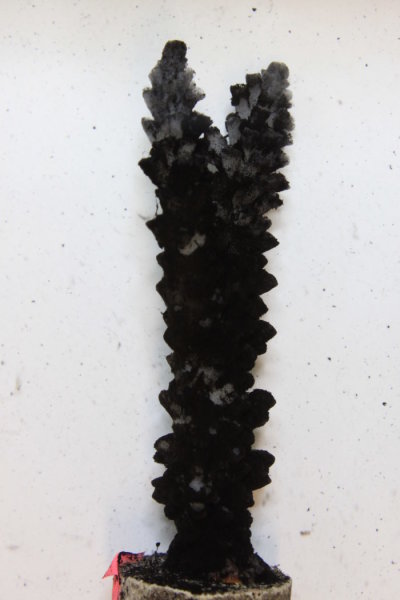
Dead coral smothered by coal. Credit: Kathryn Berry
Australian researchers have raised fresh concerns that a major shipping disaster could harm the Great Barrier Reef, with new research revealing coal dust in seawater can kill corals and slow down the growth rate of seagrasses and fish.
"Corals exposed to the highest concentrations of coal dust died within two weeks," says author Kathryn Berry, who led the experimental research.
"Corals exposed to lower concentrations of coal lasted longer, but most of them also died after 4 weeks of exposure.
"While some fish and seagrass died from coal dust exposure, it mostly stunted their growth by half compared to clean water."
The scientists exposed the marine species to fine coal particles in carefully controlled experiments within the National Sea Simulator at the Australian Institute of Marine Science and measured their responses over time.
Coal dust enters the marine environment at loading and storage facilities when it is blown or washed into the sea, during transport, and in rare shipping disasters.
In 2013, the bulk carrier, MV Smart, broke apart in South Africa while carrying over 140,000 tonnes of coal. In Australia, over 60,000 tonnes of coal remained on board the Shen Neng 1 when it ran aground on the Great Barrier Reef off Gladstone in 2010.
"Risks to the Great Barrier Reef posed by large coal spills depend on the probability of an accident and the potential impacts to marine life," says author Dr. Andrew Negri.
"While the likelihood of a major spill on a coral reef or seagrass meadow is low, we are now beginning to understand the likely consequences."
Author Dr. Mia Hoogenboom hopes the results will inform management of coal shipping activities in Australia and around the world.
"This research will allow decision makers to understand the risks to marine life to identify the species that are most vulnerable."
The findings by scientists from the ARC Centre of Excellence for Coral Reef Studies and the Australian Institute of Marine Science have been published inNature Scientific Reports.
Kathryn L. E. Berry, Mia O. Hoogenboom, Florita Flores, Andrew P. Negri. Simulated coal spill causes mortality and growth inhibition in tropical marine organisms. Scientific Reports, 2016; 6: 25894 DOI:10.1038/srep25894
Court to decide if Santos Pilliga CSG facility illegal
16 May 2016: EDO
People for the Plains, a community group from the Pilliga, represented by public interest environmental lawyers EDO NSW, is taking CSG company Santos to court over its ‘Leewood’ CSG wastewater treatment facility. People for the Plains will argue that Santos’ construction of the facility, which will process millions of litres of CSG water, is unlawful.
EDO NSW CEO and Principal Solicitor Sue Higginson says, “The Leewood facility was assessed and approved as a CSG exploration activity. Our client contends that this was incorrect. Instead, the facility should have been subject to the development assessment process under the NSW planning system. In this way, Santos would have been required to prepare a full environmental impact statement, which would have been placed on public exhibition to allow the community the opportunity to scrutinise the proposal and its impacts.”
“Environmental protection and the preservation of the rights of the community are contingent on applying and following the environmental planning laws correctly.”
“Our client is concerned that industrial scale CSG operations are incrementally rolling out across the Pilliga region as exploration activities without the community having a say, and without adequate environmental assessment or safeguards.”
The Pilliga is the largest unfragmented block of temperate dry forest in eastern Australia. It also acts as a significant recharge area for the Great Artesian Basin, one of Australia’s most important ground water resources.
More background on this case can be found at EDO NSW’s website.
The hearing commences at 9:30am on Tuesday 17 May 2016 in the Land and Environment Court, 225 Macquarie Street Sydney.
May 18, 2016 - Case update: We’ve just finished up at the People For The Plains hearing in the Land and Environment Court. Judgment is expected on 7 July 2016. In the meantime, Santos has agreed not to begin the irrigation component of the Leewood CSG wastewater project until after 8 July 2016. Thanks to barristers James Johnson and Simon Chapple for their assistance in court.
Exhibition extended for draft Kosciuszko National Park Horse Management Plan
Media release: 19 May 2016
The exhibition period for the Kosciuszko National Park Draft Wild Horse Management Plan has been extended by six weeks.
National Parks and Wildlife Service (NPWS) director Tom Bagnat said submissions on the draft plan would be accepted until 5pm, Friday 19 August.
Mr Bagnat said the level of interest in the plan was high, and he encouraged everyone to read the draft plan and associated documents.
"NPWS will host a series of community 'open house', information and feedback sessions in relation to the draft plan in Tumut, Jindabyne and Queanbeyan and with the extension of the exhibition period, these will now be held in July," Mr Bagnat said.
"NPWS understands that this is a very complex issue. This complexity is reflected in the draft plan and the detail and length of all of the supporting reports, documents and information.
"To gain a greater understanding of the issue and its complexity the NPWS recommends that people read all of these documents to gain an informed opinion on the issues involved."
A common questions and answers list has been added to the Protecting the Snowies website.
The Draft Wild Horse Management Plan and associated documents can be viewed and downloaded online as well as details on how to provide feedback can be found at:www.environment.nsw.gov.au/protectsnowies
Managing Wild Horses in Kosciuszko
Sunday, 1 May, 2016
NSW Environment Minister Mark Speakman today invited the community to have its say on the Draft Wild Horse Management Plan for Kosciuszko National Park, now on public exhibition.
Mr Speakman said while wild horses would always be part of the cultural heritage of Kosciuszko National Park, current numbers were unsustainable and the horses were damaging the park’s fragile alpine and subalpine environment.
“The draft plan outlines how the National Parks and Wildlife Service (NPWS) proposes to reduce the overall population of wild horses in the park using a range of humane and cost effective methods that will see numbers reduced from 6000 to approximately 3000 in the next five to 10 years,” Mr Speakman said.
The draft plan responds to the complex issue of wild horse management by proposing a range of humane control methods including trapping, rehoming, mustering, ground shooting, fertility control and fencing. Aerial shooting, ‘brumby running’ and ’roping’ have been ruled out.
The draft plan proposes reducing wild horse population numbers over the next 20 years to a permanent population of around 600, and identifies three locations in the park that could carry this smaller population with less environmental impact.
“Wild horse management is an emotive and complex issue. There are diverse opinions in the community and often deeply held views which polarise stakeholder groups,” Mr Speakman said.
“It is clear, however, that the broader community values the unique environment of Kosciuszko National Park and looks to NPWS to protect it.
The Draft Wild Horse Management Plan for Kosciuszko National Park and details on how to provide feedback can be found atwww.environment.nsw.gov.au/protectsnowies
The draft plan will be on public exhibition from 1 May 2016 to 19 August 2016 and during this time the community is encouraged to provide feedback.
NPWS will also host a series of open days in the Snowy Region. Please visit the Office of Environment and Heritage website for details.
New species of diatom discovered
May 16, 2016
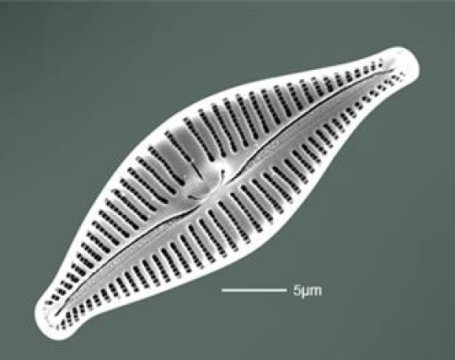
Afrocymbella barkeri was identified by Belgian taxonomists Christine Cocquyt and Els Ryken in Lake Challa, a 92-metre deep crater lake at the foot of Mount Kilimanjaro on the border of Kenya and Tanzania. Credit: Image courtesy of Lancaster University
A newly discovered species of diatom, a microscopic creature that is key to the health of the planet, is named after a Lancaster professor.
Professor Philip Barker has dedicated much of his working life to the study of diatoms, exploring what these microscopic phytoplankton can tell us about climate change and water quality.
Now his efforts have have been rewarded, with a recently identified diatom species being called Afrocymbella barkeri in his honour.
Afrocymbella barkeri was identified by Belgian taxonomists Christine Cocquyt and Els Ryken in Lake Challa, a 92-metre deep crater lake at the foot of Mount Kilimanjaro on the border of Kenya and Tanzania. Phil has spent many years there doing research into long term climate change.
The paper identifying the diatom states that: "The name barkeri is in honour of Prof. Philip A. Barker (Lancaster Environment Centre, Lancaster University, United Kingdom), a diatomist with a long-term research interest in the palaeolimnology of East Africa's lakes, including Lake Challa."
Phil may have published more than 100 peer reviewed papers and chapters, and had many accolades for his research, but having a diatom named after him is something special. "!f something is named after you, then it is there for ever," he said.
The importance of diatoms
"Diatoms are incredibly important organisms that live in oceans and fresh water," said Phil. "They contribute the same in terms of photosynthesising carbon as rainforests.
"I started using them when I did my PhD as a tool to understand past climates. They are highly diagnostic of salinity and nutrient levels but what has sustained my interest is that they are terribly beautiful."
Diatoms are a diverse group of single celled organisms, with a silica shell forming the cell wall. It was the chemistry of the shell that captured Phil's interest.
"When the diatoms die their shells get preserved in the sediment at the bottom of lakes and oceans, providing an indicator of the conditions in the water at the time when they lived."
Phil developed a series of new geochemical methods that scientists can use to analyse these preserved shells.
Drilling 250,000 years back in time
Lake Challa, where Afrocymbella barkeri was discovered, is very deep, so the sediments are not disturbed by mixing and are very well preserved.
"We have already got a record for the past 25,000 years. In November, we are hoping to drill 150 metres into the sediment and get a record of diatoms, and climate, going back 250,000 years. It will potentially give us a really good record of long term climate changes, in particular the evolution of monsoons in that part of Africa."
"This research provides a context for contemporary climate change, giving us an understanding of natural variability in climate before we start ascribing any human causes to current climate change."
It will also enable Phil to test a hypothesis about the interaction between climate and human evolution.
"Between 130,000 and 190,000 years ago, around the times Homo sapiens were evolving, there were a series of thousand-year long mega droughts in Africa. Humans will have had to change their behaviour to adapt and so maybe some of the traits we have today are a result of these droughts."
Christine Cocquyt, Els Ryken. Afrocymbella barkerisp. nov. (Bacillariophyta), a common phytoplankton component of Lake Challa, a deep crater lake in East Africa. European Journal of Phycology, 2016; 51 (2): 217 DOI:10.1080/09670262.2015.1126766
BirdLife Australia's Indigenous Grant for Bird Research and Conservation
BirdLife Australia: April 14, 2016
Indigenous knowledge of native Australian birds, their life cycle, and habitat is profound and has made a substantial contribution to the scientific study of birds in this country.
BirdLife Australia's Indigenous Grant for Bird Research and Conservation wishes to acknowledge this contribution and facilitate further engagement of Indigenous Australians in research and conservation of our native birds.
The 2016 grant is focused on migratory birds and Important Bird and Biodiversity Areas. The grant is funded from the proceeds of print sales from The Flyway Print Exchange.
Check out our website to find out more: http://bit.ly/BirdLifeAwards
Applications close 31 May.
Artificial intelligence replaces physicists
May 16, 2016: Australian National University

The experiment, featuring the small red glow of a BEC trapped in infrared laser beams. Credit: Stuart Hay, ANU
Physicists are putting themselves out of a job, using artificial intelligence to run a complex experiment.
The experiment, developed by physicists from The Australian National University (ANU) and UNSW ADFA, created an extremely cold gas trapped in a laser beam, known as a Bose-Einstein condensate, replicating the experiment that won the 2001 Nobel Prize.
"I didn't expect the machine could learn to do the experiment itself, from scratch, in under an hour," said co-lead researcher Paul Wigley from the ANU Research School of Physics and Engineering.
"A simple computer program would have taken longer than the age of the Universe to run through all the combinations and work this out."
Bose-Einstein condensates are some of the coldest places in the Universe, far colder than outer space, typically less than a billionth of a degree above absolute zero.
They could be used for mineral exploration or navigation systems as they are extremely sensitive to external disturbances, which allows them to make very precise measurements such as tiny changes in the Earth's magnetic field or gravity.
The artificial intelligence system's ability to set itself up quickly every morning and compensate for any overnight fluctuations would make this fragile technology much more useful for field measurements, said co-lead researcher Dr Michael Hush from UNSW ADFA.
"You could make a working device to measure gravity that you could take in the back of a car, and the artificial intelligence would recalibrate and fix itself no matter what," he said.
"It's cheaper than taking a physicist everywhere with you."
The team cooled the gas to around 1 microkelvin, and then handed control of the three laser beams over to the artificial intelligence to cool the trapped gas down to nanokelvin.
Researchers were surprised by the methods the system came up with to ramp down the power of the lasers.
"It did things a person wouldn't guess, such as changing one laser's power up and down, and compensating with another," said Mr Wigley.
"It may be able to come up with complicated ways humans haven't thought of to get experiments colder and make measurements more precise.
The new technique will lead to bigger and better experiments, said Dr Hush.
"Next we plan to employ the artificial intelligence to build an even larger Bose-Einstein condensate faster than we've seen ever before," he said.
The research is published in the Nature group journal Scientific Reports.
P. B. Wigley, P. J. Everitt, A. van den Hengel, J. W. Bastian, M. A. Sooriyabandara, G. D. McDonald, K. S. Hardman, C. D. Quinlivan, P. Manju, C. C. N. Kuhn, I. R. Petersen, A. N. Luiten, J. J. Hope, N. P. Robins, M. R. Hush. Fast machine-learning online optimization of ultra-cold-atom experiments. Scientific Reports, 2016; 6: 25890 DOI:10.1038/srep25890
Coviu Platform to Help Drive Inbound Medical Tourism Growth
May 18, 2016: CSIRO
A powerful audio-video platform developed by CSIRO's Data61 has the potential to raise the standard in the delivery of medical services internationally.
Coviu, a Data61 start-up, and SunWo Medical Management, a Chinese company which provides "medical tourism" services, have entered into a Memorandum of Agreement which sees the largest data innovation group in Australia licencing its digital service delivery platform to support health consultations for Chinese citizens.
This medical tourism sector is primed for growth as an increasing number of the Chinese public are seeking better quality healthcare overseas, particularly in cardiovascular disease, cancer, respiratory diseases and diabetes.
Under the agreement, Coviu and SunWo intend to collaborate around further tailoring the platform to support the sharing of medical expertise across borders.
SunWo specialises in helping its clients source and access medical treatment and hospitals in the US, Germany, Japan, and hopefully Australia in the future.
The company had been using traditional video conferencing services like Skype to connect patients, doctors and translators for such things as pre-treatment consultations and follow-up appointments.
However, SunWo found the traditional platforms to be limited and restrictive in terms of sharing medical imaging and patient data.
A recent trial of the Coviu platform impressed the company with its superior audio-video quality, including its capability around the live-sharing of medical data and imaging during calls.
SunWo's Chief Operating Officer, Mr Ben Chan, said the willingness to embrace new technology was a high priority for SunWo, which was constantly looking to enhance customer experience.
"The Coviu platform has the potential to vastly improve the quality of online interactions between patients, medical professionals and translators, which are so important to overcoming geographical barriers between countries," Mr Chan said.
Coviu Project Director, Dr Silvia Pfeiffer, said the platform's functionality made it extremely compatible with the customer service aspect of face-to-face medical consultations online.
"In many ways this platform usurps traditionally cumbersome video-conferencing systems, with its multi-party, feature-rich video capability, which supports the effortless sharing of data-hungry information such as high-definition medical imagery," Dr Pfeiffer said.
Data61 CEO Adrian Turner said this was a prime example of how innovative digital technology could be used to catalyse the growth industries of the 21st Century.
"Australia has a trusted world-class health system and renowned medical research capability," Mr Turner said.
"Here we have a Chinese company looking to Australian innovation to help grow its business in an area where two key services industries - tourism and healthcare - intersect.
"By deepening these types of relationships we benefit not only through the transfer of our digital technology, but also from potential growth in medical tourism."
Domestically, the Coviu platform can also support the expansion of 'telehealth' services in regional and remote parts of Australia, as well as in urban areas.
Home-based pulmonary rehabilitation as effective as hospital-based
May 16, 2016
Home-based pulmonary rehabilitation may be equally effective in improving fitness and quality of life as a traditional center-based program for COPD patients, according to new research presented at the ATS 2016 International Conference.
"We know that pulmonary rehab is a highly effective treatment for COPD because it improves exercise capacity and symptoms and keeps people out of the hospital," said Anne Holland, PhD, professor of physiotherapy at Alfred Health and La Trobe University, Melbourne, Australia. "But less than 10 percent of all COPD patients in developed countries enter a pulmonary rehab program."
According to Dr. Holland, a number of factors contribute to that fact, including lack of programs and inadequate or no medical reimbursement. Another factor, she said, is that for people who are short of breath, traveling to a hospital or other medical facility for rehabilitation on a regular basis "may seem impossible."
Dr. Holland and her colleagues created a unique 8-week at-home program and compared the results with their hospital's traditional outpatient program in a randomized controlled trial of 166 patients.
After an initial visit from a physiotherapist, those in the home program decided on their own exercise program and reviewed their fitness goals and progress on a weekly call with a health care professional. The caller was trained to motivate patients by asking questions that helped patients focus on what improvements were important to them. Those in the traditional program attended twice weekly sessions at the hospital. Each session included group exercise and education.
At the end of the pulmonary rehabilitation and a year later, blinded assessors measured change in six-minute walk distance (6MWD), the primary outcome. Patients also completed validated questionnaires to measure changes in dyspnea-related quality of life (Chronic Respiratory Questionnaire) and self-efficacy (Pulmonary Rehabilitation Adapted Index of Self-Efficacy, or PRAISE).
Results on all measures were comparable between participants in the two study arms immediately following program completion. Among home-based participants, 6MWD increased by 28 meters, compared to 29 meters for center-based participants. Neither group, however, retained primary or secondary gains 12 months later--a finding consistent with previous studies. Researchers also tracked hospital admissions and health care utilization and are currently analyzing that data.
The costs of the two pulmonary rehabilitation programs were similar: $219 (USD) for in-center; $209 (USD) for at-home. The low cost of at-home pulmonary rehabilitation makes it a viable option, said Dr. Holland, if clinical guidelines incorporate at-home pulmonary rehabilitation into their treatment recommendations.
"We would need appropriate funding models that recognize a telephone call from a health care professional can be a treatment," she said. "We're not there yet in Australia, and I suspect in most countries around the world."
The above is reprinted from materials provided by American Thoracic Society.
Potential 'fountain of youth' gene found
May 17, 2016
A gene that scientific dogma insists is inactive in adults actually plays a vital role in preventing the underlying cause of most heart attacks and strokes, researchers at the University of Virginia School of Medicine have determined. The discovery opens a new avenue for battling those deadly conditions, and it raises the tantalizing prospect that doctors could use the gene to prevent or delay at least some of the effects of aging.
"Finding a way to augment the expression of this gene in adult cells may have profound implications for promoting health and possibly reversing some of the detrimental effects with aging," said researcher Gary K. Owens, PhD, director of UVA's Robert M. Berne Cardiovascular Research Center.
Unexpected Protective Effect
The gene, Oct4, plays a key role in the development of all living organisms, but scientists have, until now, thought it was permanently inactivated after embryonic development. Some controversial studies have suggested it might have another function later in life, but the UVA researchers are the first to provide conclusive evidence of that: Owens and his colleagues have determined the gene plays a critical protective role during the formation of atherosclerotic plaques inside blood vessels. The rupturing of these plaques is the underlying cause of many heart attacks and strokes.
The researchers found that Oct4 controls the movement of smooth muscle cells into protective fibrous "caps" inside the plaques -- caps that make the plaques less likely to rupture. The researchers also have provided evidence that the gene promotes many changes in gene expression that are beneficial in stabilizing the plaques. This is exciting, because studies suggest that it may be possible to develop drugs or other therapeutic agents that target the Oct4 pathway as a means to reduce the incidence of heart attacks or stroke. "Our findings have major implications regarding possible novel therapeutic approaches for promoting stabilization of atherosclerotic plaques," said Olga A. Cherepanova, PhD, a senior research scientist in Owens' lab.
One surprising finding from UVA's research: When the researchers blocked the effect of Oct4 in mice, they thought the atherosclerotic plaques might become smaller, because of the reduced number of smooth muscle cells inside. Instead, the plaques grew larger, less stable and more dangerous, stuffed with lipids, dead cells and other damaging components.
Advancing Regenerative Medicine
While UVA's research has focused on how Oct4 offers cardiovascular protection, Owens and his colleagues believe the gene could also prove critical to the field of regenerative medicine, which investigates the growth and replacement of tissues and organs. The researchers believe that Oct4 and its family of target genes are activated in other somatic cells -- the non-reproductive cells in the body -- and play a key role in the cells' ability to repair damage and heal wounds. Studies to test this are under way in Owens' lab.
Oct4 is one of the "stem cell pluripotency factors" described by Shinya Yamanaka, MD, PhD, for which he received the 2012 Nobel Prize. His lab and many others have shown that artificial over-expression of Oct4 within somatic cells grown in a lab dish is essential for reprogramming these cells into induced pluripotential stem cells, which can then develop into any cell type in the body or even an entire organism.
The UVA researchers suspect that at least some of the detrimental effects of aging, including the increased possibility of a plaque rupture, stem from a decrease in the body's ability to reactivate Oct4. "Finding a way to reactivate this pathway may have profound implications for health and aging," Owens said. "We think this is just the tip of the iceberg for controlling plasticity of somatic cells, and this could impact many human diseases and the field of regenerative medicine. Who knows, this may end up being the 'fountain-of-youth gene,' a way to revitalize old and worn-out cells. Only time will tell."
Olga A Cherepanova, Delphine Gomez, Laura S Shankman, Pamela Swiatlowska, Jason Williams, Olga F Sarmento, Gabriel F Alencar, Daniel L Hess, Melissa H Bevard, Elizabeth S Greene, Meera Murgai, Stephen D Turner, Yong-Jian Geng, Stefan Bekiranov, Jessica J Connelly, Alexey Tomilin, Gary K Owens. Activation of the pluripotency factor OCT4 in smooth muscle cells is atheroprotective. Nature Medicine, 2016; DOI: 10.1038/nm.4109
Volcanic voyage of Investigator
Published on 16 May 2016: by CSIRO
Smoking, snow-covered volcanoes, soaked scientists and sticky black mud. Follow the volcanic voyage of researchers on board RV Investigator as they visit Australia’s Heard Island and McDonald Islands in early 2016. Two action-packed months at sea in three minutes of video, one second at a time! Big thanks to Pete Harmsen for putting this awesome video together.
Visit the Marine National Facility website for more information about Australia’s science super ship, RV Investigator: www.mnf.csiro.au
Shape of cities shapes the weather
May 17, 2016
The features that make cities unique are important to understanding how cities affect weather and disperse air pollutants, researchers highlight in a new study.
Compared to their surroundings, cities can be hot -- hot enough to influence the weather. Industrial, domestic, and transportation-related activities constantly release heat, and after a warm day, concrete surfaces radiate stored heat long into the night. These phenomena can be strong enough to drive thunderstorms off course. But it isn't only about the heat cities release; it's also about their spatial layout. By channeling winds and generating turbulence hundreds of meters into the atmosphere, the presence and organization of buildings also affect weather and air quality.
In an EPFL-led study published in the Journal of Boundary Layer Meteorology, researchers have shown that the way cities are represented in today's weather and air quality models fails to capture the true magnitude of some important features, such as the transfer of energy and heat in the lower atmosphere. What's more, they found that processes that atmospheric sensors are unable to sense are essential to more accurately represent cities in weather models.
Stirring up the air
When wind blows over a city, buildings interact with the moving air mass, generating turbulence, much like sticking your fingertips into a stream forms visible vortices on the water surface. This turbulence spreads up into the atmosphere and down into the streets. As a result, more heat, humidity, and pollutants are transported upwards from the ground. At the same time, more of the wind's turbulent energy dissipates between streets, in gardens, or in other open spaces.
"What we showed in our work is the importance of taking into account the spatial variability of cities -- the unique features that make Paris Paris and London London," says Marco Giometto, the first author of the study. "Most city representations used in weather models are based on data obtained from tower measurements made at a particular location within the city, which current models approximate as a rough patch of land. The transport of heat, humidity, or pollutants is then computed using mathematical relationships. These relationships implicitly assume that the city is geometrically regular, which is a stringent assumption," he says.
Giometto and his colleagues performed a series of detailed simulations of the wind flow over and within a neighborhood of the city of Basel and compared results against wind tower measurements collected within the same area. By accounting for the spatial variability of streets and buildings in the same Basel neighborhood they were able to show that, for certain parameters that play a role in the local weather and the dispersal of smoke, smog, or other pollutants, approximating the city as an uniform patch of land can lead to errors up 200 percent.
Going beyond the status quo
"Weather models obviously can't include detailed representations of all large cities," says Giometto. High-resolution simulations require time and resources that are not available to weather forecasters. Instead, he argues, going beyond the status quo of likening cities to rough patches of land will require developing new, more accurate ways to translate specific urban settings to minimalist representations that can then be integrated into a computer model.
In particular, Giometto's findings highlight the importance of accounting for dispersive terms that arise due to the spatial heterogeneity of cities. In the mathematical equations that govern the movement of the air, they do just what their name indicates: they disperse pollutants, heat, humidity, or even energy. "You can picture them as mini air-circulations, locked in between buildings that transport warm and polluted air up from ground-level on one side and draw down cleaner and cooler air on the other," says Andreas Christen, a coauthor of the study. But unlike the wind speed or direction, a single weather station is unable to measure these dispersive terms directly, which is where the computer simulations come in.
"We need accurate computer simulations of the wind over cities to estimate dispersive terms for the prevailing wind directions," says Giometto. Ultimately, this information will allow to develop accurate models, that will benefit urban residents. A better understanding of how cities affect the air within and above them, and better tools to account for these effects, would not only contribute to improving urban weather forecasts and the evaluation of the spread of pollutant plumes and smog in urban settings. In the future, they could also contribute to making cities more energy efficient and, maybe one day, a little bit less hot.
M. G. Giometto, A. Christen, C. Meneveau, J. Fang, M. Krafczyk, M. B. Parlange. Spatial Characteristics of Roughness Sublayer Mean Flow and Turbulence Over a Realistic Urban Surface. Boundary-Layer Meteorology, 2016; DOI: 10.1007/s10546-016-0157-6
The Other Left

Symptoms of 'chronic multisymptom illness' may be common in Iraq, Afghanistan vets
May 13, 2016
Army soldiers take part in a training exercise on Tactical Base Gamberi in eastern Afghanistan in 2015. Emerging research suggests a majority of Iraq and Afghanistan Veterans have symptoms consistent with a condition known as chronic multisymptom illness.
Credit: Department of Defense
In a Veterans Affairs study of more than 300 enlisted Army National Guard and Army Reserve members who had deployed to Iraq or Afghanistan, a majority reported symptoms consistent with a condition known as chronic multisymptom illness (CMI). The data were collected a year after the soldiers returned home.
The results suggest that deployment to these conflicts could trigger symptoms consistent with CMI.
The ailment presents as a combination of medically unexplained chronic symptoms, such as fatigue, headache, joint pain, indigestion, insomnia, dizziness, breathing problems, and memory problems.
The study, by researchers with VA's War-Related Illness and Injury Study Center (WRIISC) in New Jersey, appeared online Feb. 22, 2016, in theJournal of Rehabilitation Research and Development.
"As a whole, CMI can be challenging to evaluate and manage," said lead author Dr. Lisa McAndrew. "CMI is distinct from PTSD or depression. It contributes to significant disability."
McAndrew is also with the University at Albany.
In the veteran community, chronic multisymptom illness has previously been associated mainly with service during the Persian Gulf War in the early 1990s. At least a quarter of those veterans are affected.
Experts aren't sure, though, if that condition is the same one that has emerged among more recent veterans, as documented in the newest WRIISC study and one or two earlier ones. Last year, for example, researchers with the Millennium Cohort Study reported that about a third of combat veterans who served in Iraq and Afghanistan had CMI symptoms.
"This condition appears to be similar to that experienced by many Gulf War veterans, in terms of the symptoms, but we don't really know if it's the same condition," says McAndrew. "That still requires study."
McAndrew and her colleagues surveyed 319 soldiers about their overall health before they deployed and one year after they returned. The VA team found there were 150 soldiers who did not report many symptoms before they deployed but who reported symptoms of CMI one year after deployment, suggesting a link between deployment to Iraq or Afghanistan and CMI.
In total, nearly 50 percent of the overall group met the criteria for mild to moderate CMI, and about 11 percent met the criteria for severe CMI, one year after deployment.
The most common symptoms reported were trouble sleeping, moodiness or irritability, joint pain, fatigue, difficulty remembering or concentrating, headaches, and sinus congestion.
Not surprisingly, the researchers found that veterans who screened positive for CMI scored significantly lower on measures of physical and mental health function.
Of the 319 veterans in the study, 166 had chronic pain, lasting more than three months. Almost all of those with chronic pain--90 percent--also met the criteria for CMI. Similarly, 82 percent of those with CMI reported chronic pain.
The finding underscores the strong link between chronic pain and CMI, say the researchers.
The study also found that almost all veterans with PTSD symptoms also showed signs of CMI--about 98 percent. Only seven patients had PTSD and did not meet the criteria for CMI. In contrast, though, about 44 percent of the veterans with CMI did not have PTSD. In other words, the link between PTSD and CMI was not as robust as that between chronic pain and CMI.
The authors caution that the study looked only at pain and PTSD as factors tied in with CMI. It did not document other conditions that could possibly account for the symptoms of CMI, such as depression, traumatic brain injury, and substance abuse. At the same time, they say these other conditions are unlikely to completely account for the frequency of symptoms seen in the study.
By the same token, other conditions not examined in the study, such as arthritis or multiple sclerosis, could cause symptoms similar to those of CMI. More research is needed to tease out those variables.
Another limitation of the study: The research team used a definition of CMI, established by the Centers for Disease Control and Prevention (CDC), that is based on Gulf War Veterans. They say it might not exactly fit the symptoms of veterans of the more recent conflicts.
Also, it's unclear whether the Guard and Reserve members surveyed in the study are representative of the larger veteran or military cohort who deployed to Iraq and Afghanistan.
All in all, the research team advises that the results be interpreted with caution.
"We're taking the approach that an abundance of caution is necessary in the clinical implications of the findings," says McAndrew. "Respondents self-reported symptoms on pen and paper surveys. The symptoms were not confirmed or evaluated by a clinician. While the CDC case definition is fairly clear-cut, in clinical practice there is a lot of gray area around applying the label of CMI. We used the term 'symptoms consistent with CMI' to indicate the uncertainty due to the self-reported, clinician-unverified nature of the classification."
Pending further research on the topic, McAndrew's group says clinicians in VA or other settings should consider CMI when evaluating Iraq and Afghanistan Veterans, especially those with chronic pain. Once the condition is identified, clinicians in VA and the Department of Defense do have a clinical practice guideline for managing the condition.
"Acknowledging the presence of multiple symptoms and taking a holistic approach to achieving patient goals is critical in managing CMI," says McAndrew. For example, pain management may need to be tailored to account for other symptoms of CMI.
The WRIISC study notwithstanding, McAndrew says not enough attention has been focused on the issue to date.
"There have been few studies of CMI among Iraq and Afghanistan veterans. Our findings suggest this could be an overlooked problem."
Senior researcher on the WRIISC study was Dr. Karen Quigley, now at the Edith Nourse Rogers Memorial Veterans Hospital and Northeastern University.
Journal Reference:
Lisa M. McAndrew, Drew A. Helmer, L. Alison Phillips, Helena K. Chandler, Kathleen Ray, Karen S. Quigley. Iraq and Afghanistan Veterans report symptoms consistent with chronic multisymptom illness one year after deployment. Journal of Rehabilitation Research and Development, 2016; 53 (1): 59 DOI:10.1682/JRRD.2014.10.0255

Disclaimer: These articles are not intended to provide medical advice, diagnosis or treatment. Views expressed here do not necessarily reflect those of Pittwater Online News or its staff.